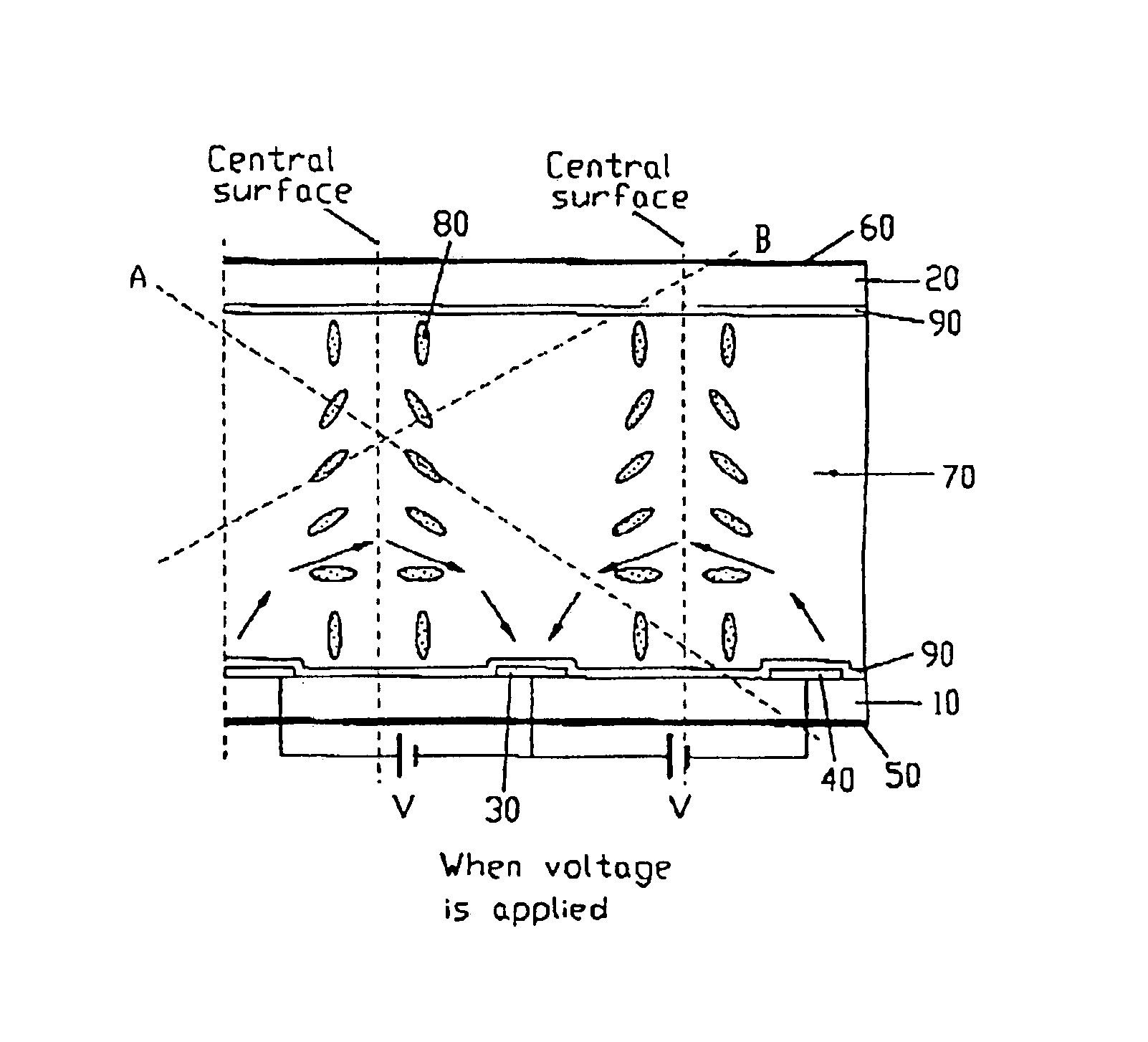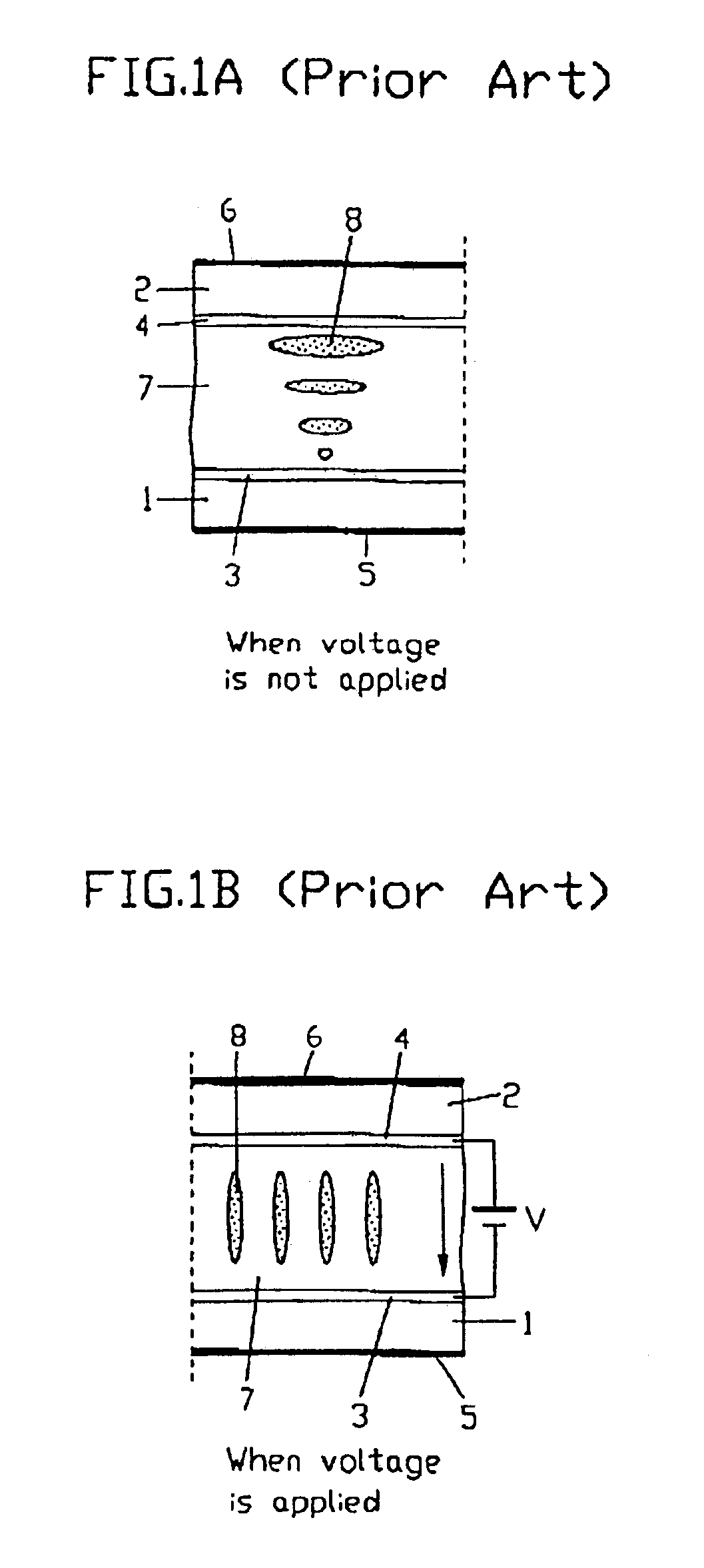Liquid crystal display
a liquid crystal display and display technology, applied in non-linear optics, instruments, optics, etc., can solve the problems of narrow viewing angle, decreased response speed, undesirable effects of ips-lcd on contrast ratio, etc., and achieve the effect of wide viewing angl
- Summary
- Abstract
- Description
- Claims
- Application Information
AI Technical Summary
Benefits of technology
Problems solved by technology
Method used
Image
Examples
example 1
The nematic liquid crystal having chiral dopant and the pure nematic liquid crystal were used as the liquid crystal layer 70, and the resulting viewing angles were measured for each case.
The refractive anisotropy n of the liquid crystal layer 70 was 0.09, the thickness d of the liquid crystal layer 70 was 4.5 μm, and the alignment films 90 were not rubbed. In addition, the two electrodes 30 and 40 were horizontally formed, and the transmission axes of the polarizing plates 50 and 60 attached to the outward surfaces of the two substrates 10 and 20 were formed to have an angle of 90° with respect to each other. The transmission axis of one polarizing plate were formed to have an angle of 45° with respect to the two electrodes 30 and 40, and the transmission axis of the other polarizing plate were formed to have an angle of 135° with respect to the two electrodes 30 and 40. The angles have been measured by setting the right side of the horizontal direction as zero degree.
FIG. 7 is a gr...
example 2
While maintaining the same condition as in example 1, the alignment films 90 formed on the two substrates 10 and 20 were rubbed, and the resulting viewing angles were measured in each case.
FIG. 9 is a graphical illustration of a viewing angle of the EOC-LCD obtained when the alignment film 90 formed on the upper substrate 20 was rubbed in the angle of 135° and when the alignment film 90 formed on the lower substrate 10 is rubbed in the angle of 315 °.
FIG. 10 is a graphical illustration of viewing angles of the EOC-LCD obtained when the alignment film 90 formed on the upper substrate 20 was rubbed in the angle of 45° and the alignment film 90 formed on the lower substrate 10 was rubbed in the angle of 225 °.
As shown in FIGS. 9 and 10, more uniform viewing angle can be obtained since the difference between the viewing angles in the horizontal and the vertical direction and the viewing angle in the diagonal direction can be reduced by rubbing the alignment films as described above.
example 3
While maintaining the same condition as in example 1, the viewing angle was measured by varying the orientations of the polarizing plates 50 and 60 attached to the outward surfaces of the two substrates 10 and 20.
FIG. 11 is a graphical illustration of viewing angles of the EOC-LCD obtained by arranging the transmission axis of the polarizing plates 60 attached to the outward surface of the upper substrates 20 to make an angle of 45° with respect to the direction of the two electrodes 30 and 40, and by arranging the transmission axis of the polarizing plate 50 attached to the lower substrate 10 to make an angle of 135° with respect to the direction of the two electrodes 30 and 40.
FIG. 12 is a graphical illustration of viewing angles of the EOC-LCD obtained by arranging the transmission axis of the polarizing plates 60 attached to the upper substrates 20 to make an angle of 30°, and by arranging the transmission axis of the polarizing plate 50 attached to the lower substrate 10 to mak...
PUM
| Property | Measurement | Unit |
|---|---|---|
| width | aaaaa | aaaaa |
| width | aaaaa | aaaaa |
| thickness | aaaaa | aaaaa |
Abstract
Description
Claims
Application Information
 Login to View More
Login to View More - R&D
- Intellectual Property
- Life Sciences
- Materials
- Tech Scout
- Unparalleled Data Quality
- Higher Quality Content
- 60% Fewer Hallucinations
Browse by: Latest US Patents, China's latest patents, Technical Efficacy Thesaurus, Application Domain, Technology Topic, Popular Technical Reports.
© 2025 PatSnap. All rights reserved.Legal|Privacy policy|Modern Slavery Act Transparency Statement|Sitemap|About US| Contact US: help@patsnap.com



